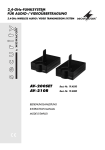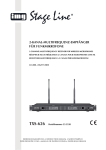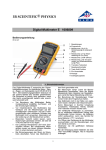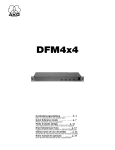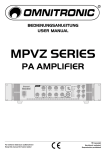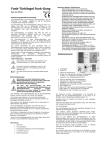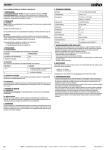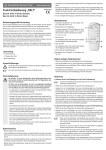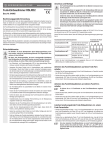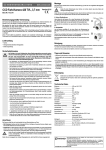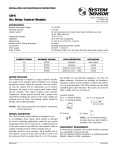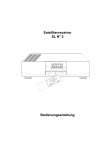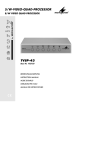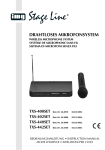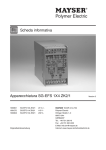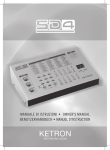Download AV-3040TX - Monacor Sverige AB
Transcript
2,4-GHz-FUNKSYSTEM 10-mW-SENDER 2.4 GHz WIRELESS TRANSMISSION SYSTEM 10 mW TRANSMITTER AV-3040TX Best.-Nr. 19.5060 BEDIENUNGSANLEITUNG INSTRUCTION MANUAL MODE D’EMPLOI ISTRUZIONI PER L’USO ® ® AV-3040TX D A CH GB ACHTUNG! Änderung der Bedienungsanleitung ATTENTION! Modification of the instruction manual Das Kapitel 3.1 „Zulassung“ in der Bedienungsanleitung ist nicht mehr gültig. Der aktuelle Text für dieses Kapitel lautet wie folgt: The chapter 3.1 “Approval” in the instruction manual is no longer valid; the current text of this chapter reads as follows: Konformität und Zulassung Hiermit erklärt MONACOR INTERNATIONAL, dass sich der Sender in Übereinstimmung mit den grundlegenden Anforderungen und den übrigen einschlägigen Bestimmungen der Richtlinie 1995/5/EG befindet. Die Konformitätserklärung kann im Internet über die Homepage von MONACOR INTERNATIONAL abgerufen werden (www.monacor.com). Der Sender ist für den Betrieb in den EU- und EFTA-Staaten allgemein zugelassen und anmelde- und gebührenfrei. Conformity and Approval Herewith, MONACOR INTERNATIONAL declare that the transmitter is in accordance with the basic requirements and the other relevant regulations of the directive 1995/5/EC. The declaration of conformity can be found in the Internet via the MONACOR INTERNATIONAL home page (www.monacor.com). The transmitter is licence-free and generally approved for operation in EU and EFTA countries. Bewahren Sie dieses Beiblatt immer zusammen mit der Bedienungsanleitung auf. Always keep this supplementary sheet together with the instruction manual. DEUTSCH Bevor Sie einschalten … ENGLISH Before switching on … Wir wünschen Ihnen viel Spaß mit Ihrem neuen Gerät von MONACOR. Bitte lesen Sie diese Bedienungsanleitung vor dem Betrieb gründlich durch. Nur so lernen Sie alle Funktionsmöglichkeiten kennen, vermeiden Fehlbedienungen und schützen sich und Ihr Gerät vor eventuellen Schäden durch unsachgemäßen Gebrauch. Heben Sie die Anleitung für ein späteres Nachlesen auf. Der deutsche Text beginnt auf der Seite 6. FRANÇAIS Avant toute installation … ITALIANO We wish you much pleasure with your new MONACOR unit. Please read these operating instructions carefully prior to operating the unit. Thus, you will get to know all functions of the unit, operating errors will be prevented, and yourself and the unit will be protected against any damage caused by improper use. Please keep the operating instructions for later use. The English text starts on page 8. Prima di accendere … Nous vous souhaitons beaucoup de plaisir à utiliser cet appareil MONACOR. Lisez ce mode d'emploi entièrement avant toute utilisation. Uniquement ainsi, vous pourrez apprendre l’ensemble des possibilités de fonctionnement de l’appareil, éviter toute manipulation erronée et vous protéger, ainsi que l’appareil, de dommages éventuels engendrés par une utilisation inadaptée. Conservez la notice pour pouvoir vous y reporter ultérieurement. La version française se trouve page 10. Vi auguriamo buon divertimento con il vostro nuovo apparecchio di MONACOR. Leggete attentamente le istruzioni prima di mettere in funzione l'apparecchio. Solo così potete conoscere tutte le funzionalità, evitare comandi sbagliati e proteggere voi stessi e l'apparecchio da eventuali danni in seguito ad un uso improprio. Conservate le istruzioni per poterle consultare anche in futuro. Il testo italiano inizia a pagina 12. 3 4 channel channel selection test switch audio level 1 2 3 4 video in audio A in 5 ➀ audio B DC 7-30V in switching channel in GND 6 7 8 9 ➁ 5 DEUTSCH Bitte klappen Sie die Seite 5 heraus. Sie sehen dann immer die beschriebenen Bedienelemente und Anschlüsse. 1 Übersicht der Bedienelemente und Anschlüsse 1.1 Frontseite 1 Kanalanzeige 2 Taste „channel selection“ zur Einstellung des Empfangskanals 1 – 5 3 Taste „test switch“ zum Testen des Schaltkanals 4 Regler „audio level“ zum Einstellen der Empfindlichkeit für die Audioeingänge (8); Regelbereich 500 mV – 10 V 5 hochklapp- und drehbare Sendeantenne (nicht verkratzen) 1.2 Rückseite 6 2polige Klemmleiste für den Schaltkanaleingang zum Anschluss z. B. eines Bewegungssensors mit NO-Kontakt Zum Aktivieren des Schaltkanals die beiden Anschlüsse kurzschließen. 7 Cinch-Buchse „video in“ für den Videoeingang; 1 Vss/75 Ω 8 Cinch-Buchsen „audio A in“ und „audio B in“ für die Audioeingänge; Eingangsempfindlichkeit mit dem Regler „audio level“ (4) von 500 mV bis 10 V einstellbar 9 Kleinspannungsbuchse „DC 7-30V“ für die Spannungsversorgung mit 7 – 30 V /max. 130 mA; Mittelkontakt = Pluspol; benötigter Kleinspannungsstecker 5,5/2,1 mm (Außen-/Innendurchmesser) 2 Wichtige Hinweise für den Gebrauch Der Sender entspricht allen erforderlichen Richtlinien der EU und ist deshalb mit gekennzeichnet. ● Verwenden Sie den Sender nur im Innenbereich. Schützen Sie ihn vor Tropf- und Spritzwasser, hoher Luftfeuchtigkeit und extremen Temperaturen (zulässiger Einsatztemperaturbereich -10 °C bis +55 °C). ● Verwenden Sie für die Reinigung nur ein trockenes, weiches Tuch, auf keinen Fall Chemikalien oder Wasser. ● Wird der Sender zweckentfremdet, nicht richtig angeschlossen, falsch bedient oder nicht fachgerecht repariert, kann keine Haftung für daraus resultierende Sach- oder Personenschäden und keine Garantie für den Sender übernommen werden. Soll der Sender endgültig aus dem Betrieb genommen werden, übergeben Sie ihn zur umweltgerechten Entsorgung einem örtlichen Recyclingbetrieb. 6 3 Einsatzmöglichkeiten Der Sender AV-3040TX dient in Verbindung mit einem 2,4-GHz-Empfänger der Serie „AV-3...R“ von MONACOR zur drahtlosen Übertragung von Videound Audiosignalen. Zum Aufbau einer drahtlosen Video-Überwachungsanlage werden zusätzlich nur noch eine Videokamera und ein Monitor benötigt. Die Übertragungsreichweite hängt stark von den örtlichen Gegebenheiten ab. Bei Sichtverbindung zwischen Sender und Empfänger kann sie bis zu 500 m betragen. In Gebäuden reduziert sich die Reichweite jedoch durch die Wände und Decken je nach deren Beschaffenheit auf ca. 50 m. Durch die Verwendung einer gewinnbringenden Antenne am Empfänger kann die Reichweite jedoch um ein Mehrfaches erhöht werden. 3.1 Zulassung Die Zulassung für den Sender AV-3040TX ist nach der R + TTE-Richtlinie (Radio and Telecommunication Technical Equipment) in den Staaten der Europäischen Union gültig. Für den Betrieb in Staaten außerhalb der EU fragen Sie bitte Ihren Fachhändler oder die MONACOR-Niederlassung des entsprechenden Landes. 4 Inbetriebnahme 4.1 Platzierung von Sender und Empfänger Die beste Empfangsqualität erhält man, wenn die Antenne des Senders und des Empfängers parallel zueinander stehen. Nach der Inbetriebnahme am Sender dazu die Antenne (5) senkrecht hochklappen und auf optimalen Empfang drehen. Erfahrungen aus der Praxis haben gezeigt, dass ein optimaler Empfang bei einer Aufstellung in einer Höhe von mindestens 1,5 bis 2 m über dem Boden erreicht wird. Vor der endgültigen Montage sollte ein Probebetrieb erfolgen, da bereits durch Verschieben von Sender und Empfänger um nur einige Zentimeter sich die Übertragungsqualität erheblich ändern kann. 4.2 Geräte anschließen Vor dem Anschließen von Geräten bzw. Ändern bestehender Anschlüsse den Sender und alle anderen Geräte der Überwachungsanlage ausschalten. 1) Das Videosignal der Kamera bzw. der Signalquelle über ein 75-Ω-Koaxialkabel auf die Cinchbuchse „video in“ (7) geben. Der Pegel des Videosignals muss normgerecht 1 Vss betragen. 2) Zur Tonübertragung das Audiosignal der Kamera bzw. der Signalquelle über ein abgeschirmtes Audiokabel auf die Buchse „audio A in“ geben und bei einer Stereoübertragung zusätzlich auf die Buchse „audio B in“ (8). 3) Ist der verwendete Empfänger mit einem Schaltkanal ausgestattet, lässt sich ein an ihm angeschlossener optischer bzw. akustischer Signalgeber hierüber aktivieren oder ein anderes Zusatzgerät (z. B. Videorecorder, um eine Aufnahme 4.3 Einstellungen vornehmen 4.3.1 Kanalwahl Die Funkübertragung erfolgt im 2,4-GHz-Bereich, der vom Hersteller in fünf Kanäle mit einem Abstand von 14 MHz aufgeteilt wurde. Maximal können gleichzeitig drei Kanäle benutzt werden (Kanal 1, 3 und 5), weil zwei direkt nebeneinander liegende Kanäle sich stören. Es wird folgende Kanalwahl empfohlen: bei zwei Sendern: Kanal 1 und 5 bei drei Sendern: Kanal 1, 3 und 5 Den Sendekanal mit der Taste „channel selection“ (2) einstellen. Dieser wird in der Kanalanzeige (1) angegeben. 5 Technische Daten Sendefrequenz: . . . . . . . . Kanal 1 Kanal 2 Kanal 3 Kanal 4 Kanal 5 2,4145 GHz 2,4285 GHz 2,4425 GHz 2,4565 GHz 2,4705 GHz DEUTSCH automatisch zu starten). Am Sender wird der Schaltkanal durch Kurzschließen der Klemmanschlüsse (6) aktiviert. An diese z. B. einen Bewegungssensor mit Schließkontakt (NO) anschließen. Zum Testen des Schaltkanals nach der Inbetriebnahme die Taste „test switch“ (3) betätigen. Für die Dauer des Tastendrucks wird ein Schaltsignal gesendet, welches das am Schaltausgang des Empfängers angeschlossene Gerät aktiviert. 4) Zur Stromversorgung wird ein stabilisiertes Netzgerät mit einer Ausgangsspannung zwischen 7 V und 30 V und einem Ausgangsstrom von mindestens 150 mA benötigt, z. B. PS-500ST von MONACOR. Bei Netzgeräten mit variabler Ausgangsspannung diese zwischen 7 V und 30 V einstellen. Das Netzgerät über einen Kleinspannungsstecker 5,5/2,1 mm (Außen-/Innendurchmesser) an die Buchse „DC 7-30V“ (9) anschließen. Dabei unbedingt die Polung beachten: den Pluspol an den Innenkontakt des Steckers anlegen. Nach dem Anschluss der Versorgungsspannung ist der Sender betriebsbereit und die Kanalanzeige (1) leuchtet. Sendeleistung: . . . . . . . . . 10 mW (EIRP) Antenne: . . . . . . . . . . . . . Platinenantenne Reichweite bei Sichtverbindung: . . bis 500 m in Gebäuden: . . . . . . . . bis 50 m Video Eingangspegel: . . . . . . 1 Vss ±0,1 Vss an 75 Ω Bandbreite: . . . . . . . . . 30 Hz – 5 MHz Audio Tonträgerfrequenz Ton A: . . . . . . . . . . . . Ton B: . . . . . . . . . . . Eingangspegel: . . . . . . Bandbreite: . . . . . . . . . 6,5 MHz 5,5 MHz 500 mV – 10 V an 10 kΩ 15 Hz – 15 kHz Modulation Audio/Video: . frequenzmoduliert F3F Schaltkanal Trägerfrequenz: . . . . . . 32 kHz Eingang: . . . . . . . . . . . für Schließer (NO-Kontakt) Stromversorgung: . . . . . . 7 – 30 V /max. 130 mA Einsatztemperatur: . . . . . -10 °C bis +55 °C Abmessungen ohne Antenne (B x H x T): 105 x 48 x 100 mm Gewicht: . . . . . . . . . . . . . . 470 g Änderungen vorbehalten. 4.3.2 Audiopegel einstellen Die Eingangsempfindlichkeit der Eingänge „audio A in“ und „audio B in“ (8) lässt sich mit dem Regler „audio level“ (4) von 500 mV bis 10 V einstellen. Das Tonsignal am Empfänger bzw. Monitor darf weder verzerren, dann den Regler entsprechend zurückdrehen, noch verrauscht sein, dann den Regler entsprechend weiter aufdrehen. Diese Bedienungsanleitung ist urheberrechtlich für MONACOR ® INTERNATIONAL GmbH & Co. KG geschützt. Eine Reproduktion für eigene kommerzielle Zwecke – auch auszugsweise – ist untersagt. 7 ENGLISH Please unfold page 5. Then you can always see the operating elements and connections described. 1 Operating Elements and Connections 1.1 Front panel 1 Channel display 2 Button “channel selection” for adjusting the receiving channels 1 – 5 3 Button “test switch” for testing the control channel 4 Control “audio level” for adjusting the sensitivity of the audio inputs (8); control range 500 mV – 10 V 5 Transmitting antenna, to be folded out and turned (antenna must not be scratched) 1.2 Rear panel 6 2-pole terminal strip for the control channel input for connecting e. g. a motion detector with NO (normally open) contact To activate the control channel, short-circuit the two connections. 7 Phono jack “video in” for the video input; 1 Vpp/75 Ω 8 Phono jacks “audio A in” and “audio B in” for the audio inputs; input sensitivity adjustable from 500 mV to 10 V with the control “audio level” (4) 9 Low voltage jack “DC 7-30 V” for the power supply with 7 – 30 V /max. 130 mA; centre contact = positive pole; required low voltage plug 5.5/2.1 mm (outside/ inside diameter) 2 Important Notes The transmitter corresponds to all required directives of the EU and is therefore marked with . ● The transmitter is suitable for indoor use only. Protect it against dripping water and splash water, high air humidity, and extreme temperatures (admissible ambient temperature range -10 °C to +55 °C). ● For cleaning only use a dry, soft cloth, by no means chemicals or water. ● No guarantee claims for the transmitter and no liability for any resulting personal damage or material damage will be accepted if the transmitter is used for other purposes than originally intended, if it is not correctly connected or operated or not repaired in an expert way. If the transmitter is to be put out of operation definitively, take it to a local recycling plant for a disposal which is not harmful to the environment. 8 3 Applications In combination with a 2.4 GHz receiver of the MONACOR “AV-3...R” series, the transmitter AV-3040 TX serves for wireless transmission of video and audio signals. For setting up a wireless video surveillance system, merely a video camera and a monitor are additionally required. The transmission range largely depends on the local conditions. Without any obstacles between the transmitter and the receiver, the maximum range is 500 m. However, in buildings it is reduced to approx. 50 m by walls and ceilings, depending on their condition. By using an antenna with gain at the receiver, the range can be increased many times over. 3.1 Approval According to the R+TTE directive (Radio and Telecommunication Technical Equipment), the approval for the transmitter AV-3040TX is valid in the countries of the European Union. For operation in countries outside the EU, please contact your retailer or the MONACOR subsidiary in the country where this unit will be operated. 4 Operation 4.1 Placing the transmitter and the receiver The highest reception quality is achieved when placing the antennas of the transmitter and the receiver in parallel. For this purpose, after setting the unit into operation, unfold the antenna (5) vertically and turn it to optimum reception. Practical experience has shown that an optimum reception is achieved when placing the units at a height of minimum 1.5 m to 2 m above the ground. Prior to final mounting, a trial run is recommended as the transmission quality can be substantially changed by displacing the transmitter and the receiver by a few centimetres only. 4.2 Connecting units Prior to connecting any units or to changing any existing connections, switch off the transmitter and all other units of the surveillance system. 1) Feed the video signal of the camera or the signal source via a 75 Ω coaxial cable to the phono jack “video in” (7). The level of the video signal must be 1 Vpp according to standard. 2) For audio transmission, feed the audio signal of the camera or the signal source via a shielded audio cable to the jack “audio A in” and, in case of stereo transmission, additionally to the jack “audio B in” (8). 3) If the receiver used is provided with a control channel, it is possible to activate an optical or acoustic signal device or another additional unit connected to the receiver via this channel (e. g. 5 4.3 Adjustments Control channel Carrier frequency: . . . . 32 kHz Input: . . . . . . . . . . . . . . for NO (normally open) contact 4.3.1 Channel selection The wireless transmission is made in the 2.4 GHz range which has been divided by the manufacturer into five channels with a distance of 14 MHz. As a maximum, three channels can be used simultaneously (channels 1, 3, and 5) as two adjacent channels will interfere with each other. The following channel selection is recommended: for two transmitters: channels 1 and 5 for three transmitters: channels 1, 3, and 5 Specifications Transmitting frequency: . . channel 1 channel 2 channel 3 channel 4 channel 5 2.4145 GHz 2.4285 GHz 2.4425 GHz 2.4565 GHz 2.4705 GHz ENGLISH video recorder for automatic start of a recording). On the transmitter, the control channel is activated by short-circuiting the terminals (6). Connect e. g. a motion detector with NO (normally open) contact to these terminals. For testing the control channel after setting the transmitter into operation, actuate the button “test switch” (3). As long as the button is actuated, a control signal is transmitted which will activate the unit connected to the control output of the receiver. 4) For power supply, a regulated power supply unit with an output voltage between 7 V and 30 V and an output current of at least 150 mA is required, e. g. MONACOR PS-500ST. In case of power supply units with variable output voltage, adjust a value between 7 V and 30 V. Connect the power supply unit via a low voltage plug 5.5/ 2.1 mm (outside/inside diameter) to the jack “DC 7-30 V” (9). Always observe the correct polarity: connect the positive pole to the inner contact of the plug. After the supply voltage has been applied, the transmitter is ready for operation and the channel display (1) lights up. Transmitting power: . . . . . 10 mW (EIRP) Antenna: . . . . . . . . . . . . . PCB antenna Operating range without any obstacles: . 500 m max. in buildings: . . . . . . . . . 50 m max. Video Input level: . . . . . . . . . . 1 Vpp ±0.1 Vpp at 75 Ω Bandwidth: . . . . . . . . . . 30 Hz – 5 MHz Audio Audio carrier frequency Audio A . . . . . . . . . . Audio B: . . . . . . . . . . Input level: . . . . . . . . . . Bandwidth: . . . . . . . . . . 6.5 MHz 5.5 MHz 500 mV – 10 V at 10 kΩ 15 Hz – 15 kHz Modulation audio/video: . frequency modulated F3F Power supply: . . . . . . . . . 7 – 30 V /max. 130 mA Ambient temperature: . . . -10 °C to +55 °C Dimensions w/o antenna (W x H x D): . . . . . . . . . . . 105 x 48 x 100 mm Weight: . . . . . . . . . . . . . . . 470 g Subject to technical modification. Adjust the transmission channel with the button “channel selection” (2). The selected channel will then appear on the channel display (1). 4.3.2 Adjusting the audio level The input sensitivity of the inputs “audio A in” and “audio B in” (8) can be adjusted from 500 mV to 10 V with the control “audio level” (4). The audio signal at the receiver or the monitor must neither be distorted (in this case turn back the control correspondingly) nor noisy (in this case advance the control correspondingly). All rights reserved by MONACOR ® INTERNATIONAL GmbH & Co. KG. No part of this instruction manual may be reproduced in any form or by any means for any commercial use. 9 FRANÇAIS Ouvrez le présent livret page 5 de manière à visualiser les éléments et branchements. 1 Eléments et branchements 1.1 Face avant 1 Affichage du canal 2 Touche “channel selection” pour régler le canal de réception 1 à 5 3 Touche “test switch” pour tester le canal de commutation 4 Réglage “audio level” pour régler la sensibilité pour les entrées audio (8) : plage de réglage 500 mV – 10 V 5 Antenne émettrice dépliable et tournante (ne pas érafler l’antenne) 1.2 Face arrière 6 Barrette 2 pôles pour l’entrée du canal de commutation pour brancher par exemple un détecteur de mouvements avec contact NO Pour activer le canal de commutation, court-circuitez les deux branchements. 7 Prise RCA “video in” pour l’entrée vidéo : 1 Vcc/75 Ω 8 Prises RCA “audio A in” et “audio B in” pour les entrées audio ; sensibilité d’entrée réglable avec le réglage “audio level” (4) de 500 mV à 10 V 9 Prise basse tension “DC 7-30V” pour la tension d’alimentation avec 7 – 30 V /130 mA max ; contact médian = pôle plus Une fiche basse tension 5,5/2,1 mm (diamètre extérieur/intérieur) est nécessaire. 2 Conseils importants d’utilisation L’émetteur répond à toutes les directives nécessaires de l’Union Européenne et porte donc le symbole . ● L’émetteur n’est conçu que pour une utilisation en intérieur. Protégez-le des projections d’eau et éclaboussures, d’une humidité élevée de l’air et de températures extrêmes (plage de température de fonctionnement autorisée : -10 °C à +55 °C). ● Pour le nettoyer, utilisez uniquement un chiffon sec et doux, en aucun cas de produits chimiques ou d’eau. ● Nous déclinons toute responsabilité en cas de dommages corporels ou matériels résultants si l’émetteur est utilisé dans un but autre que celui pour lequel il a été conçu, s’il n’est pas correctement branché, utilisé ou réparé par une personne habilitée; en outre, la garantie deviendrait caduque. Lorsque l’émetteur est définitivement retiré du service, vous devez le déposer dans une usine de recyclage de proximité pour contribuer à son élimination non polluante. 10 3 Possibilités d’utilisation L’émetteur AV-3040TX, combiné à un récepteur 2,4 GHz de la série “AV-3…R” de MONACOR sert pour une transmission sans fil de signaux vidéo et audio. Pour créer une installation de surveillance vidéo sans fil, une caméra vidéo et un moniteur uniquement sont, en plus, nécessaires. La portée de transmission dépend grandement de la configuration des lieux d’utilisation. Lorsqu’il n’y a pas d’obstacle entre l’émetteur et le récepteur, elle peut atteindre 500 m. Dans des bâtiments, elle diminue jusqu’à 50 m environ selon la composition des murs et plafonds. Si vous utilisez une antenne avec gain sur le récepteur, la portée peut être augmentée plusieurs fois. 3.1 Autorisation L’autorisation pour l’émetteur AV-3040TX est, selon la directive R+TTE (Radio and Telecommunication Technical Equipment), valable dans les pays de l’Union Européenne. Pour un fonctionnement en dehors de l’Union Européenne, contactez votre revendeur ou la succursale MONACOR dans le pays concerné. 4 Fonctionnement 4.1 Placement de l’émetteur et du récepteur La qualité de réception est optimale lorsque les antennes de l’émetteur et du récepteur sont parallèles. Après la mise en fonction, sur l’émetteur, déployez l’antenne (5) à la verticale et tournez-la vers la réception optimale. L’expérience montre que la réception est optimale pour un positionnement des appareils à une hauteur de 1,5 m à 2 m au moins au-dessus du sol. Avant le montage définitif, il est conseillé d’effectuer un test car un déplacement de l’émetteur et du récepteur de quelques centimètres uniquement peut modifier considérablement la qualité de transmission. 4.2 Branchements des appareils Avant de brancher les appareils ou de modifier les branchements existants, veillez à éteindre l’émetteur et tous les appareils de l’installation de surveillance. 1) Appliquez le signal vidéo de la caméra ou de la source de signal via un câble coaxial 75 Ω à la prise RCA “video in” (7). Le niveau du signal vidéo doit, selon la norme, être de 1 Vcc. 2) Pour la transmission audio, appliquez le signal audio de la caméra ou de la source de signal via un cordon audio blindé à la prise “audio A in” et pour une transmission stéréo, en plus à la prise “audio B in” (8). 3) Si le récepteur utilisé est doté d’un canal de commutation, on peut activer un avertisseur optique ou acoustique ou un appareil supplémentaire (par exemple magnétoscope pour démarrer automatiquement un enregistrement) branché à ce canal. Le canal de commutation est activé, côté émet- 4.4 Réglages 4.4.1 Sélection des canaux La transmission sans fil s’effectue dans la plage 2,4 GHz, divisée par le fabricant en cinq canaux avec une distance de 14 MHz. On peut utiliser simultanément trois canaux (canal 1, 3 et 5) au plus car deux canaux directement consécutifs se perturbent. La sélection suivante de canaux est recommandée : Pour deux émetteurs : canaux 1 et 5 Pour trois émetteurs : canaux 1, 3 et 5 Réglez le canal d’émission avec la touche “channel selection” (2), il est indiqué sur l’affichage de canal (1). 4.4.2 Réglage du niveau audio La sensibilité d’entrée des entrées “audio A in” et “audio B in” (8) se règle avec le réglage “audio level” (4) de 500 mV à 10 V. Le signal audio sur le récepteur ou le moniteur ne doit pas être distordu, tournez, dans ce cas, le réglage en arrière, ni bruyant – ouvrez le réglage en conséquence. 5 Caractéristiques techniques Fréquence d’émission : . . canal 1 canal 2 canal 3 canal 4 canal 5 2,4145 GHz 2,4285 GHz 2,4425 GHz 2,4565 GHz 2,4705 GHz FRANÇAIS teur, en court-circuitant les bornes (6). On peut relier par exemple à ces bornes un détecteur de mouvements avec contact de fermeture (NO). Pour tester le canal de commutation, après la mise en fonction, activez la touche “test switch” (3). Tant que la touche est activée, un signal de contrôle est émis, il active l’appareil relié à la sortie de commutation du récepteur. 4) Pour l’alimentation, une alimentation stabilisée avec une tension de sortie entre 7 V et 30 V et un courant de sortie de 150 mA au moins est nécessaire, p. ex. PS-500ST de MONACOR. Pour des alimentations avec une tension de sortie variable, réglez-la entre 7 V et 30 V. Reliez l’alimentation via une fiche basse tension 5,5/2,1 mm (extérieur/intérieur) à la prise “DC 7-30V” (9). Veillez à respecter la polarité : le pôle plus est au contact intérieur de la fiche. L’émetteur est prêt à fonctionner une fois la tension de fonctionnement appliquée, l’affichage de canal (1) brille. Puissance émission : . . . . 10 mW (EIRP) Antenne : . . . . . . . . . . . . . antenne platine Portée en l’absence d’obstacle : . . . . . . . . . jusqu’à 500 m en intérieur : . . . . . . . . . jusqu’à 50 m Vidéo Niveau d’entrée : . . . . . 1 Vcc ±0,1 Vcc sous 75 Ω Largeur de bande : . . . 30 Hz – 5 MHz Audio Fréquence porteuse audio Son A : . . . . . . . . . . . 6,5 MHz Son B : . . . . . . . . . . . 5,5 MHz Niveau d’entrée : . . . . . 500 mV – 10 V sous 10 kΩ Largeur de bande : . . . 15 Hz – 15 kHz Modulation Audio/Vidéo : modulation de fréquence F3F Canal de commutation Fréquence porteuse : . 32 kHz Entrée : . . . . . . . . . . . . pour fermeture (contact NO) Alimentation : . . . . . . . . . . 7 – 30 V /130 mA max. Température fonc. : . . . . . -10 °C jusqu’à +55 °C Dimensions sans antenne (l x h x p) : . 105 x 48 x 100 mm Poids : . . . . . . . . . . . . . . . 470 g Tout droit de modification réservé. Notice d’utilisation protégée par le copyright de MONACOR ® INTERNATIONAL GmbH & Co. KG. Toute reproduction même partielle à des fins commerciales est interdite. 11 ITALIANO Vi preghiamo di aprire completamente la pagina 5. Così vedrete sempre gli elementi di comando e i collegamenti descritti. 1 Elementi di comando e collegamenti 1.1 Lato frontale 1 Indicazione dei canali 2 Tasto “channel selection” per impostare il canale di ricezione 1 – 5 3 Tasto “test switch” per testare il canale di controllo 4 Regolatore “audio level” per impostare la sensibilità per gli ingressi audio (8); range di regolazione 500 mV – 10 V 5 Antenna di ricezione alzabile e girevole (non graffiarla) 1.2 Lato posteriore 6 Morsettiera a 2 poli per l’ingresso del canale di controllo per il collegamento p. es. di un sensore di movimento con contatto NA Per attivare il canale di controllo mettere in corto i due contatti. 7 Presa RCA “video in” per l’ingresso video; 1 Vpp/75 Ω 8 Prese RCA “audio A in” e “audio B in” per gli ingressi audio; la sensibilità d’ingresso è impostabile con il regolatore “audio level” (4) da 500 mV fino 10 V 9 Presa per alimentazione “DC 7-30 V” per 7 – 30 V /max. 130 mA; contatto centrale = polo positivo; spinotto richiesto 5,5/2,1 mm (diametro esterno/interno) 2 Avvertenze importanti per l’uso Il trasmettitore è conforme a tutte le direttive richieste dell’UE e pertanto porta la sigla . ● Usare il trasmettitore solo all’interno di locali. Proteggerlo dall’acqua gocciolante e dagli spruzzi d’acqua, da alta umidità dell’aria e dal calore (temperatura d’impiego ammessa fra -10 °C e +55 °C). ● Per la pulizia usare solo un panno morbido, asciutto; non impiegare in nessun caso prodotti chimici o acqua. ● Nel caso d’uso improprio, di collegamenti sbagliatI, d’impiego scorretto o di riparazione non a regola d’arte del trasmettitore, non si assume nessuna responsabilità per eventuali danni consequenziali a persone o a cose e non si assume nessuna garanzia per l’apparecchio. Se si desidera eliminare il trasmettitore definitivamente, consegnarlo per lo smaltimento ad un’istituzione locale per il riciclaggio. 12 3 Possibilità d’impiego Il trasmettitore AV-3040TX, insieme ad un ricevitore a 2,4 GHz della serie “AV-3...R” di MONACOR serve per la trasmissione wireless di segnali video e audio. Per creare un impianto senza fili di sorveglianza video bastano in aggiunta una telecamera e un monitor. La portata di trasmissione dipende fortemente dalle condizioni locali e dall’antenna di ricezione impiegata. Se non ci sono ostacoli fra trasmettitore e ricevitore, può arrivare fino a 500 m. Negli edifici, la portata è ridotta per via delle pareti e dei soffitti, a seconda delle loro caratteristiche, a 50 m ca. Impiegando un’antenna con guadagno sul ricevitore, la portata può essere aumentata più volte. 3.1 Omologazione Secondo la direttiva R+TTE (Radio and Telecommunication Technical Equipment), l’omologazione del trasmettitore AV-3040TX è valida negli stati dell’Unione Europea. Per l’impiego in stati extracomunitari occorre informarsi presso il rivenditore o la rispettiva filiale MONACOR. 4 Messa in funzione 4.1 Posizionamento di trasmettitore e ricevitore La migliore qualità di ricezione si ottiene quando le antenne del trasmettitore e del ricevitore sono sistemate in modo parallelo. Dopo la messa in funzione sul trasmettitore, alzare l’antenna (5) in senso verticale e girarla per una ricezione ottimale. L’esperienza pratica ha dimostrato che si ottiene una ricezione ottimale posizionando gli apparecchi ad un’altezza di non meno di 1,5 m a 2 m dal pavimento. Prima del montaggio definitivo conviene fare delle prove, perché uno spostamento del trasmettitore e del ricevitore anche di pochi centimetri può modificare notevolmente la qualità di trasmissione. 4.2 Collegare gli apparecchi Prima di collegare degli apparecchi o modificare dei collegamenti esistenti occorre spegnere il trasmettitore e tutti gli altri apparecchi dell’impianto di sorveglianza 1) Portare il segnale video della telecamera o della sorgente dei segnali per mezzo di un cavo coassiale 75 Ω sulla presa RCA “video in” (7). Il livello del segnale video deve essere 1 Vpp come da norma. 2) Per la trasmissione audio, portare il segnale audio della telecamera o della sorgente sulla presa RCA “audio A in” servendosi di un cavo schermato e, nel caso di una trasmissione stereo, in più sulla presa RCA “audio B in” (8). 3) Se il ricevitore usato dispone di un canale di controllo, è possibile attivare con questo un segnalatore ottico o acustico collegato oppure un altro dispositivo (p. es. un videoregistratore per avviare automaticamente una registrazione). Sul lato del trasmettitore, il canale di controllo viene attivato 4.3 Effettuare le impostazioni 5 Dati tecnici Frequenza di trasmissione: Canale 1 Canale 2 Canale 3 Canale 4 Canale 5 2,4145 GHz 2,4285 GHz 2,4425 GHz 2,4565 GHz 2,4705 GHz ITALIANO mettendo in corto i morsetti (6). Collegare con questi morsetti p. es. un segnalatore di movimento con contatto di lavoro (NA). Per testare il canale di controllo azionare, dopo la messa in funzione, il tasto “test switch” (3). Per la durata della pressione del tasto viene inviato un segnale sonoro che attiva il dispositivo collegato con il canale di controllo del ricevitore. 4) Per l’alimentazione è richiesto un alimentatore stabilizzato con tensione d’uscita fra 7 V e 30 V e con corrente d’uscita di 150 mA min., p. es. PS-500ST di MONACOR. In caso di alimentatori con tensione d’uscita variabile impostare la tensione fra 7 V e 30 V. Collegare l’alimentatore con la presa “DC 7-30V” (9) servendosi di uno spinotto 5,5/2,1 mm (diametro esterno/interno). Rispettare assolutamente la corretta polarità: il polo positivo al contatto interno dello spinotto. Dopo aver applicato al tensione d’esercizio, il trasmettitore è acceso e la spia interna di funzionamento (1) rimane accesa. Potenza di trasmissione: . 10 mW (EIRP) Antenna: . . . . . . . . . . . . . antenna sul circuito stampato Portata in linea diretta senza ostacoli: . . . . . . . fino a 500 m in edifici: . . . . . . . . . . . . fino a 50 m Video Livello d’ingresso: . . . . 1 Vpp ±0,1 Vpp con 75 Ω Banda passante: . . . . . 30 Hz – 5 MHz Audio Frequenza della portante Tono A: . . . . . . . . . . . 6,5 MHz Tono B: . . . . . . . . . . 5,5 MHz Livello d’ingresso: . . . . 500 mV – 10 V con 10 kΩ Banda passante: . . . . . 15 Hz – 15 kHz 4.3.1 Scelta dei canali La trasmissione wireless avviene nel settore dei 2,4 GHz, suddiviso dal produttore in cinque canali distanti di 14 MHz gli uni dagli altri. Si possono usare contemporaneamente al massimo tre canali (canali 1, 3 e 5), perché due canali adiacenti creerebbero delle interferenze. È consigliabile la seguente scelta dei canali: con due trasmettitori: canali 1 e 5 con tre trasmettitori: canali 1, 3 e 5 Modulazione Audio/Video: modulazione di frequenza F3F Impostare il canale di trasmissione con il tasto “channel selection” (2). Il canale selzionato viene indicato sul display (1). Peso: . . . . . . . . . . . . . . . . 470 g Canale di controllo Frequenza portante: . . 32 kHz Ingresso: . . . . . . . . . . . per contatto di lavoro (NA) Alimentazione: . . . . . . . . . 7 – 30 V /130 mA max. Temperatura d’esercizio: . -10 °C a +55 °C Dimensioni senza antenna (l x h x p): 105 x 48 x 100 mm Con riserva di modifiche tecniche. 4.3.2 Impostare il livello audio La sensibilità degli ingressi “audio A in” e “audio B in” (8) può essere impostata con il regolatore “audio level” (4) da 500 mV fino a 10 V. Il segnale audio sul ricevitore o monitor non deve essere distorto (allora abbassare il regolatore) e non deve presentare un fruscio (in questo caso aprire di più il regolatore). La MONACOR ® INTERNATIONAL GmbH & Co. KG si riserva ogni diritto di elaborazione in qualsiasi forma delle presenti istruzioni per l’uso. La riproduzione – anche parziale – per propri scopi commerciali è vietata. 13 ® Copyright © by MONACOR INTERNATIONAL GmbH & Co. KG, Bremen, Germany. All rights reserved. A-0058.98.02.11.2006














